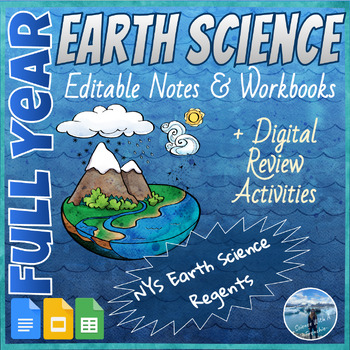Bundle: NYS Earth Science Notes & Notebooks with Digital Review Activities
Science With A Frenchie
165 Followers
Grade Levels
8th - 11th
Subjects
Resource Type
Standards
CCSSRST.9-10.4
CCSSRST.9-10.5
CCSSRST.9-10.7
NGSSHS-ESS2-5
NGSSHS-ESS1-6
Formats Included
- Zip
- Google Apps™
Pages
11 Notes and Workbooks and 23 Digital Self-Checking Review Activities
Science With A Frenchie
165 Followers

Includes Google Apps™
This bundle contains one or more resources with Google apps (e.g. docs, slides, etc.).
Products in this Bundle (38)
showing 1-5 of 38 products
Description
This growing bundle includes everything your students need to know for the New York State (NYS) Regents Earth Science course.
⭐ Save 20% ⭐
This bundle includes 11 earth and space science notes and workbooks with associated digital review activities for the NYS ESRT, which are part of the explain and elaborate phases of the 5E's learning cycle of the NGSS.
Which Notes & Workbooks are included?
- Topographic Maps
- Earth's Layers
- Geologic History
- Astronomy:
- Universe & Stars
- The Planets of the Solar System
- The Sun-Earth-Moon System
- Plate Tectonics
- Earthquakes & Tsunamis
- Rocks & Minerals
- Weathering, Erosion & Deposition
- Weather
- Climate Factors
Notes & Workbooks coming out soon:
- Earth's waters: the Water Cycle and Groundwater
Editable: You can edit all the Google Docs™ and Google Slides™.
Digital Reviews of the ESRT (made with Google Sheets™):
- Digital Task Cards:
- Weathering & Erosion Task Cards (Sink it! game)
- Astronomy Task Cards (Sink it! game)
- Earth-Sun-Moon System Digital Task Cards Review Activity (Puzzled)
- The Universe & Stars Task Cards | Digital Review Activity (Picture Suddoku)
- Weather & Meteorology Task Cards (Sink it! game)
- Climate & Water Task Cards (Riddles/Rebus game)
- Topographic Maps (Unscramble it game)
- Latitude & Longitude Digital Task Cards Review Activity (Puzzled)
- Dynamic Earth: Earth Interior, Earthquakes, and Tectonic Plates (Unscramble it! game)
- Rocks & Rock Cycle Task Cards | Digital Review Activity (Picture Suddoku)
- Geologic History Digital Task Cards Activity (Puzzled)
- Earth Science Regents Review Task Cards #1 (Unscramble it! game)
- Pixel Arts:
- Tectonic Plates Pixel Art Review | ESRT page 5
- Pixel Art Review - Stream Velocity and Transported Particle Size | ESRT Page 6
- Earthquake P-Wave and S-Wave Travel Time | ESRT page 11
- The Electromagnetic Spectrum | ESRT page 14
- Atmosphere and Planetary Winds | ESRT page 1 and 14
- Planets of the Solar System Review | ESRT page 15
- HR Diagram & Characteristics of Stars | ESRT page 15
- Picture Riddles:
- ESRT Scavenger Hunt #1
- Earth's Interior Review | ESRT Page 10
- Bedrock Geology & Landscapes of NYS | ESRT pages 2, 3, 8, and 9
- Image Reveals:
- Sink It! Game:
⭐ Follow me for 50% of new resources!
Total Pages
11 Notes and Workbooks and 23 Digital Self-Checking Review Activities
Answer Key
Included
Teaching Duration
1 Year
Report this resource to TPT
Reported resources will be reviewed by our team. Report this resource to let us know if this resource violates TPT’s content guidelines.
Standards
to see state-specific standards (only available in the US).
CCSSRST.9-10.4
Determine the meaning of symbols, key terms, and other domain-specific words and phrases as they are used in a specific scientific or technical context relevant to grades 9–10 texts and topics.
CCSSRST.9-10.5
Analyze the structure of the relationships among concepts in a text, including relationships among key terms (e.g., force, friction, reaction force, energy).
CCSSRST.9-10.7
Translate quantitative or technical information expressed in words in a text into visual form (e.g., a table or chart) and translate information expressed visually or mathematically (e.g., in an equation) into words.
NGSSHS-ESS2-5
Plan and conduct an investigation of the properties of water and its effects on Earth materials and surface processes. Emphasis is on mechanical and chemical investigations with water and a variety of solid materials to provide the evidence for connections between the hydrologic cycle and system interactions commonly known as the rock cycle. Examples of mechanical investigations include stream transportation and deposition using a stream table, erosion using variations in soil moisture content, or frost wedging by the expansion of water as it freezes. Examples of chemical investigations include chemical weathering and recrystallization (by testing the solubility of different materials) or melt generation (by examining how water lowers the melting temperature of most solids).
NGSSHS-ESS1-6
Apply scientific reasoning and evidence from ancient Earth materials, meteorites, and other planetary surfaces to construct an account of Earth’s formation and early history. Emphasis is on using available evidence within the solar system to reconstruct the early history of Earth, which formed along with the rest of the solar system 4.6 billion years ago. Examples of evidence include the absolute ages of ancient materials (obtained by radiometric dating of meteorites, moon rocks, and Earth’s oldest minerals), the sizes and compositions of solar system objects, and the impact cratering record of planetary surfaces.





